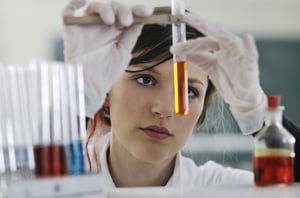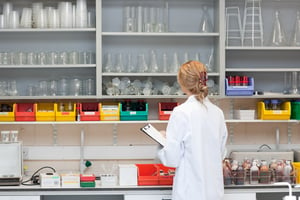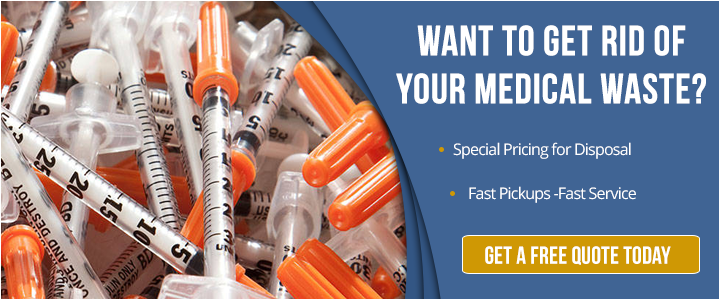Chemical waste is an unavoidable byproduct of many processes: medical tests, hospital procedures, pharmaceutical manufacturing, laboratory research and experimentation. However, the fact that such byproducts are unavoidable does not excuse poor handling of those materials and improper medical waste disposall, which can endanger people and property.
 Unfortunately, U.S. labs don’t have the highest confidence levels in their favor. According to a recent study, “94% of senior researchers felt that appropriate safety measures were in place in their laboratories, only 69% of junior researchers agreed.”
Unfortunately, U.S. labs don’t have the highest confidence levels in their favor. According to a recent study, “94% of senior researchers felt that appropriate safety measures were in place in their laboratories, only 69% of junior researchers agreed.”
This is especially true given the prevalence of mishaps: “Serious accidents, such as chemical burns and chemical inhalation, also seem to occur reasonably frequently, with 30% of researchers aware of at least one ‘major’ injury occurring in a laboratory they were working in.”
Plus, statistics from the BLS reflect an incidence rate of 3.3 injury cases (as of 2015) for every 100 people, every year. In other words, the numbers aren’t great. That’s why it’s so important to understand the basics of lab waste storage, packing and removal. Today, you’ll get a comprehensive overview of just that.
Store Chemicals and Chemical Waste Properly
First and foremost, proper waste handling starts with proper storage. As we outline here, it is critical that you:
- Separate incompatible chemicals, or those that could react dangerously
- Post chemical abbreviation sheets
- Label storage places not intended for food, flammables and other specific substances
- Include each chemical’s pertinent dates (received, opened, tested, etc.) and specifics
- Keep an accurate inventory
- Store chemicals in containers that won’t degrade with exposure to the chemical
Once you have a good storage system in place, it becomes much easier to separate your chemicals and keep the lab safe. Moreover, you then face a much smaller (and less dangerous) chore when it comes time to pack up those chemicals and send them off to a waste disposal facility.
Identify, Categorize and Separate Each Chemical
.jpeg?width=200&name=Antique%20medical%20arsenal%20Corked%20glass%20bottles%20of%20medicine%20in%20wooden%20box%20during%20reenactment%20of%20a%20battle%20in%20the%20American%20Civil%20War%20(1861-1865).jpeg) The next step for properly disposing of hazardous waste is to identify, categorize and segregate materials so as to package them correctly for shipment. This is incredibly important, because you don’t want incompatible materials jostling around during transport.
The next step for properly disposing of hazardous waste is to identify, categorize and segregate materials so as to package them correctly for shipment. This is incredibly important, because you don’t want incompatible materials jostling around during transport.
Also, you must make sure that chemicals get to the right waste disposal facilities. Chemical waste disposal, for instance, is different from bio hazardous waste disposal, which is in turn different from non-hazardous lab waste. Ditto corrosive and reactive waste, and so on.
Pack All Chemicals Properly
Since your chemicals are already labeled and stored with like substances (see above step), it’s a simple process of selecting the substances that require disposal and packing them together in a lab pack, or drum made specially for chemical disposal. Corrosives go in one container, flammables in another, reactives in another.
Once you have packed up like chemicals, you then fill the drum with an absorbent and cushioning material, such as vermiculite, to contain the possibility damage to containers inside.
Dispose of Empty Containers Safely
 Believe it or not, even empty containers need proper disposal. Whether or not those containers have recently contained chemicals, they may still have trace elements on them that are bad for people and the environment, or that can react dangerously for other substances. Never put hazardous chemicals in a storage container that was once used for a different chemical, unless it’s a reusable nonreactive vessel (e.g. glass flask or beaker).
Believe it or not, even empty containers need proper disposal. Whether or not those containers have recently contained chemicals, they may still have trace elements on them that are bad for people and the environment, or that can react dangerously for other substances. Never put hazardous chemicals in a storage container that was once used for a different chemical, unless it’s a reusable nonreactive vessel (e.g. glass flask or beaker).
To dispose of these containers, you have to check the regulations for each chemical. On a basic level, however, you can wash some containers, while others need special treatment. Be sure to check individual rules for solid waste, aerosol containers, gas cylinders and others.
There also exist different rule for the disposal of containers by size: specifically, those that are smaller than 5 gallons, those that are larger, and those that are equal.
Move Chemicals Still in Use Carefully
Even if you’re not quite ready to discard some chemicals, you must still handle them very carefully. Let’s say you’re organizing the lab and moving chemicals around, or perhaps you’re moving to a new lab and transporting them across campus. Whatever the case, your in-use chemicals can pose just as severe a danger as waste if you’re not careful.
It’s important to keep chemicals separated by type before, during and after the transition. Storage and carry incompatible chemicals in different containers to prevent a serious accident. Before moving, perform a visual inspection to determine chemicals are still safe and that containers are in good condition. Note crystal formation and dispose of those chemicals and containers according to proper waste disposal procedures rather than moving them.
Lastly, plan for the move carefully and prepare all chemicals for transport according to their specific instructions on the MSDS (material safety data sheet).


Comment